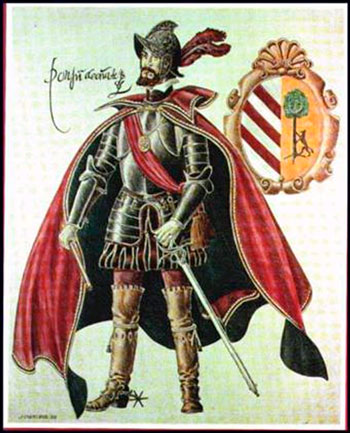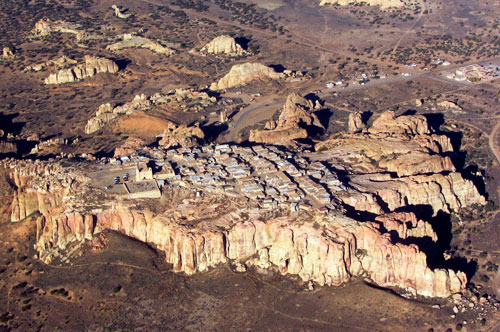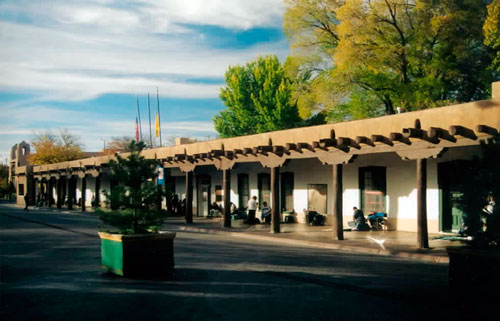In the sixties of the sixteenth century were found large silver mines in Chihuahua, which marked the northernmost area colonized by Spanish explorers. The possibility of more mines and other riches beyond this area aroused the curiosity and ambition of new explorers. But a new problem had arisen for these conquistadors: Spanish King Carlos I approved in 1541 the Leyes Nuevas de Indias according to which violent conquests had been strictly forbidden. These had to be peaceful, accompanied by religious and using dialogue and persuasion to convince the Indians to join the Spanish crown and accept the Christian religion. And, of course, further north of Chihuhua were the lands of the apaches Indians, a warrior people and very difficult to overcome. But still, volunteers came forward to undertake such expeditions.

On September 21th, 1595 the Viceroy of Nueva España Don Luis de Velasco signed a contract with Don Juan de Oñate, born in Zacatecas (Nueva España), son of the conqueror Cristóbal de Oñate, captain of Hernán Cortés, and Catalina de Salazar y de la Cadena, by which he was given permission to colonize the territory of what are now the states of New Mexico and Texas. The goal of this mission was to spread the Catholic faith among Native Americans and to create new missions in a peaceful and non-violent manner. It was an expedition of colonization since it counted among its members women and children and a large number of cattle, provisions and tools to build. Under that contract, Juan de Oñate was to become the Adelantado, captain general and governor of New Mexico.
They did not leave until January 26th, 1598. In front of them went Captain Vicente de Zaldívar, Oñate’s nephew, along with 17 men who were inspecting the road before the big caravan arrived. On April 20th, they crossed the Rio Grande and finished crossing the desert of Chihuahua, in what today could be El Paso, and stopped to build a church and celebrate a Mass of Thanksgiving. They declared also Spanish sovereignty over these territories. They also celebrated a small play composed by the religious Marcos Farfán about the evangelization of the natives, being this the first theatrical representation in the history in the territory of the present USA.
They continued their journey northward and engaged in discussions with various Indian tribes who were made aware of the expedition’s intentions to found and populate those territories and extend their religion. The chieftains initially agreed and the first Spanish population was founded in New Mexico, San Gabriel, specifically on August 18th, 1598. There they rebuilt an old abandoned Indian village and spent the winter. The first settlers were eager to see that the land they were traveling and where they were going to populate was a hard and very dry land, difficult to cultivate and always under the threat of Indian attacks. This made them think again and begin to repent of the chosen path.
The rebellion into the expedition was not long in coming. 45 families asked to return to Mexico and abandon the mission, but Oñate could not allow it. The rebels were arrested and accused of deserters trying to punish them, but the Franciscan religious intervened and managed to calm their spirits by obtaining the governor’s forgiveness. However, soon after, four soldiers deserted and Oñate ordered Captain Gaspar Pérez de Villagrá to pursue them and captured two of them. Both were accused of treason and disregarding their word of honor as noblemen and were condemned to death and executed on the outskirts of San Gabriel.
Once the mood calmed, Oñate thought that there must be better lands to create a great city and economy, so he organized an expedition with Vicente de Zaldívar at the head to explore the lands east of San Gabriel and find those herds of bison that had heard so much and could save the expedition. Happily they found these herds and explored all that territory with the idea of finding the Atlantic ocean, something they thought was close by.

The Oñate group headed east leaving San Gabriel behind and crossed the salt-lake plains, Puaray and arrived in Acoma on October 27th, 1598. This was a city built on top of a small plateau with cliffs almost 100 meters high. An almost impregnable place that astonished the Spaniards. The queres Indians were the ones who lived there and came down to greet strangers, inviting Oñate and his assistants to visit the city. There they were entertained and returned shortly afterwards, continuing on the road to Moqui and Zuñi.
Meanwhile Vicente de Zaldívar returned to San Gabriel in search of the bulk of the expedition to tell Oñate what they had explored and discovered on their journey to the east, but Oñate had already left. They spent a few days there recovering their strength and on November 18th they went out after their steps and these took them to the city of Acoma and its impressive cliffs. They were equally well received by the Indian chiefs and leaving 16 men downstairs they went up with 14 soldiers to visit the city of clouds. In their walk through it they were scattered without realizing the situation of danger that was being generated. Suddenly and at the signal of a brutal scream from one of the chiefs, all the inhabitants of the city stepped on the Spaniards and killed or wounded them. Only four of them escaped by throwing themselves through the steep walls and reaching where the horrified group of Spaniards who were down on the plain found themselves. They fled the scene and headed for Moqui to alert Oñate to what had happened and that a great rebellion of the Pueblo indians was being prepared. They returned to San Gabriel and fortified it. Oñate prepared an expedition of punishment against Acoma but it was complicated, he only had 200 soldiers and in Acoma there were at least 300 warriors to which had to be added several Navajo Indians who joined them.
As it was not possible to leave without soldiers or direction, San Gabriel had to choose a captain to command an action against Acoma and Vicente Zaldívar was the volunteer to lead it. On January 12th, 1599, 70 men set out to conquer the city of the clouds, a natural fortress that seemed impregnable. At first they demanded that the Indians hand over the perpetrators of the deaths of the Spaniards killed there in November, with the idea that if they gave it to them they could reach an agreement and pacify the area but it was an illusion without any possibility. All the proposals were rejected with a shower of arrows and stones thrown from the top of the city.
On January 22th, at dawn, the Spaniards enjoyed several groups of twelve. The first of these groups at night took up position near the top of the city without being seen. Just below them other Spanish soldiers perched in cracks built a small portable bridge. Meanwhile, on the northern slope, Zaldívar launched a fun attack to attract the attention of the Indians, leaving the flank where they had placed the canyon and where they were preparing to hang the bridge. They fired the cannon and hung the bridge, managing to enter the city and face the Indians who, after a long and intense struggle, had to surrender and accept the orders of the Spaniards. Acoma had fallen, but at a high price in life of the Indians, however the Spaniards only had two dead.

This victory settled the settlers in New Mexico, their success reached every corner of the area warning of the strength and bravery of those conquerors but still there were Indian tribes that continued to rise and fight. They returned to San Gabriel and after all the casualties suffered Oñate asked the king for human and material reinforcements arriving in December 1600. This refreshment motivated Oñate to organize new expeditions.
He sent Vicente Zaldívar with 70 men to the shores of California looking for maritime communication but they failed to get out of supplies too soon. He same left again to the east towards Quivira finding only poor and dry land. There was nothing to find over there. But the worst thing was when they returned to San Gabriel and found that a large group of settlers fed up with living in such a lonely and unlikely place to thrive took their things and returned to Mexico without permission. The viceroy forgave them because he understood perfectly well their reasons for that betrayal and did not act against them.
These events undermined Oñate’s authority until he was finally removed from his position as governor of New Mexico and replaced by a settler: Juan Martínez de Montoya. And this in 1609 was replaced by Pedro de Peralta, who was ordered to create an embryonic city in the capital of New Mexico. To this end, he founded Santa Fe and the surviving settlers of San Gabriel moved there. Through this place would pass the Royal Road of Tierra Adentro through which was organized a great expedition called “conducta” that carried and brought all kinds of products, food, furniture, objects, etc., needed by the colony.
Santa Fe was the first capital of territory in the United States that managed to settle and reach our days despite being a frequent target of Apache attacks and harsh weather and terrain.
Index of the conquest and colonization of North America
- Spanish conquest and colonization of North America.- Ponce de león and the Discovery of de Florida.
- Francisco de Garay, Expeditions along the Gulf of Mexico Coast.
- Lucas Vázquez de Ayllón, Foundation of the First Spanish Settlement in North America.
- Esteban Gómez, exploration of the entire east coast.
- Pánfilo de Narváez and Cabeza de Vaca, exploration of the Southern United States
- Nuño de Guzmán, conquistador of Nueva Galicia
- The Viceroy Mendoza and the Seven Cities of Cibola
- Hernando de Soto, the great American marathon
- Francisco Vázquez de Coronado, Arizona y Nuevo México, Texas, Kansas and Oklahoma
- Juan Rodríguez Cabrillo and the discovery of California
- Menéndez de Avilés found San Agustín of the Florida
- Juan de Oñate, the conquest of New Mexico
- The peaceful conquest
- The conquest of Texas, the Missions
- The conquest of California
- Los Caminos Reales Españoles
- The Spanish Alaska
- The Spanish Louisiana
- The loss of North America